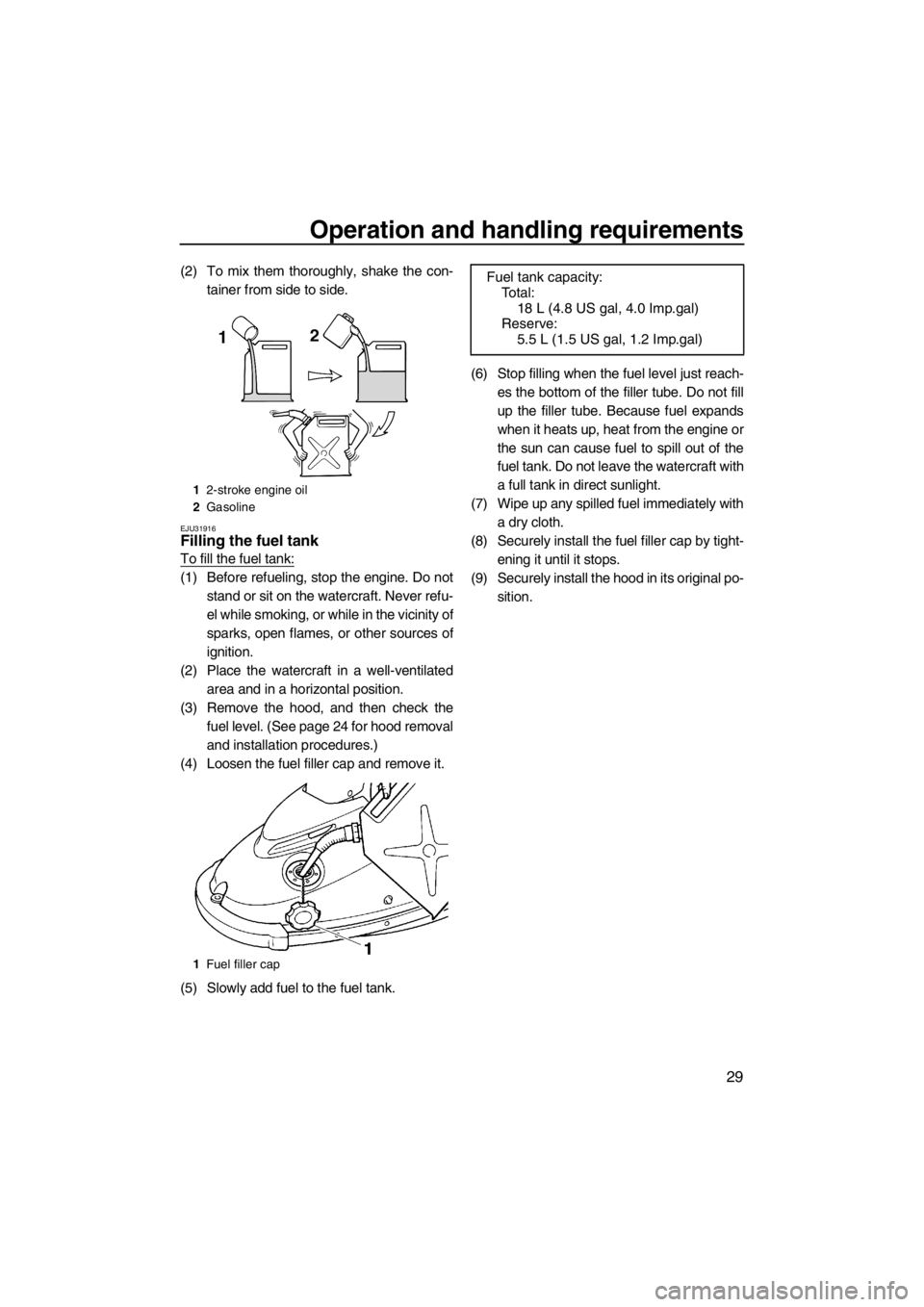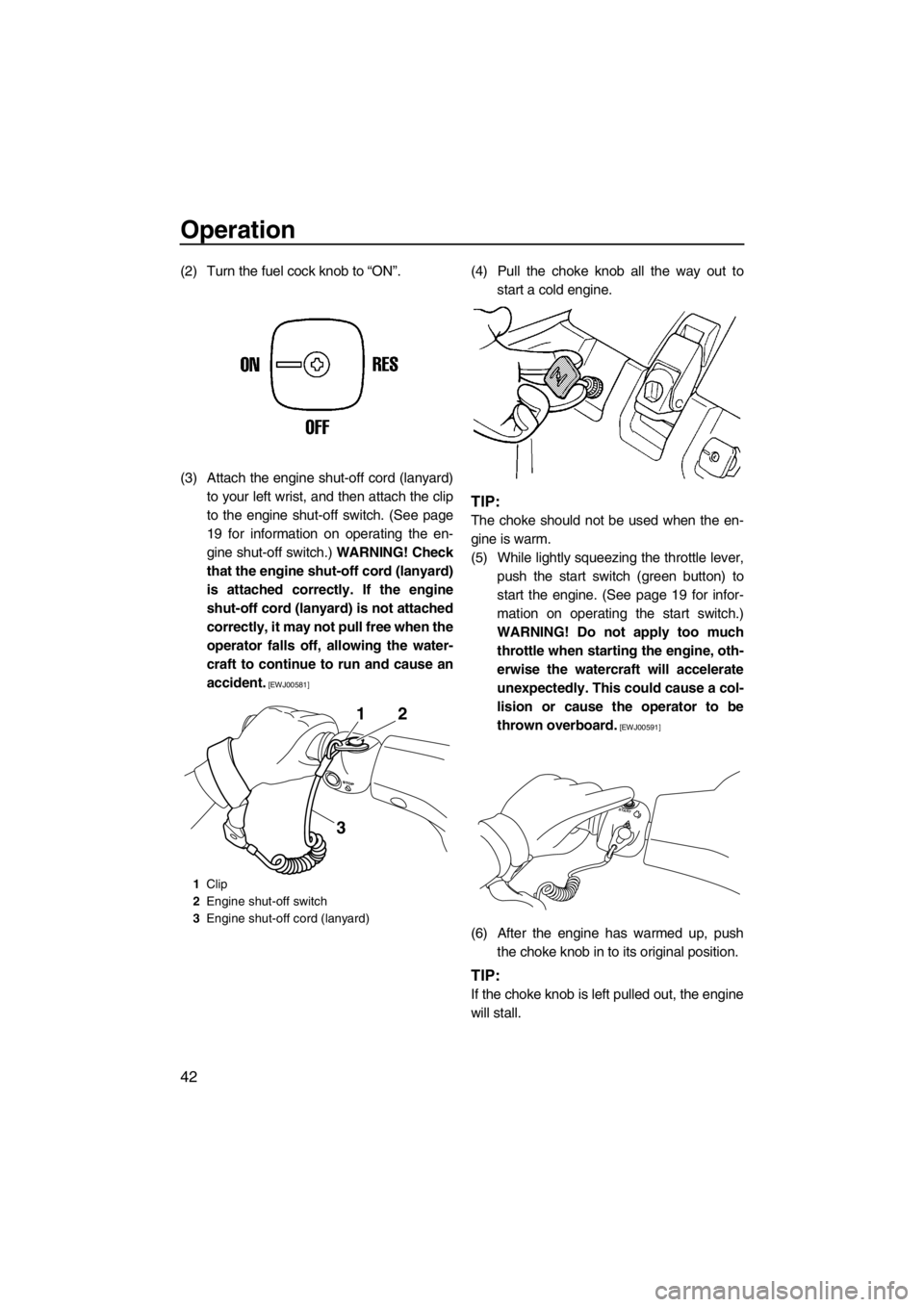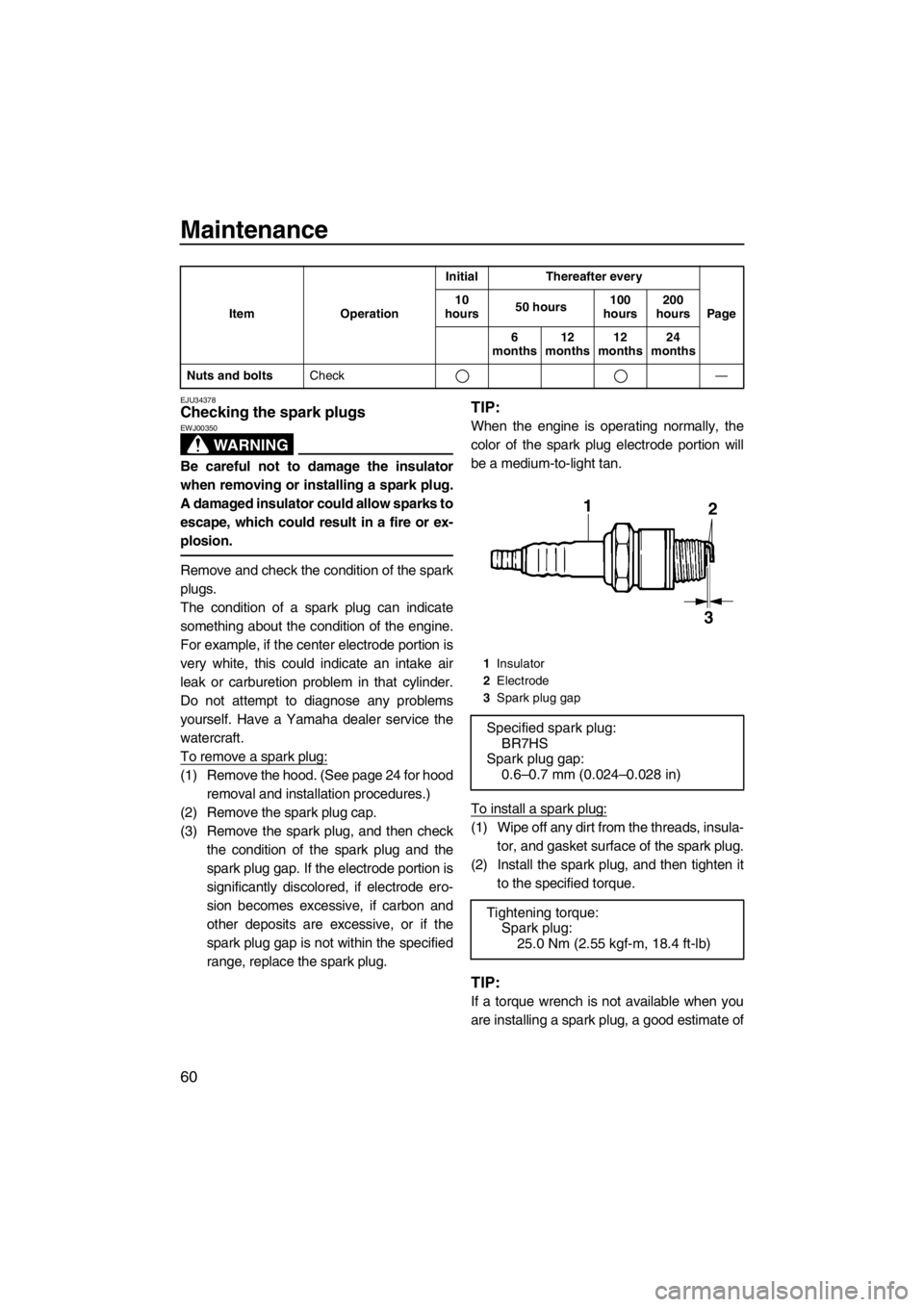2013 YAMAHA SUPERJET light
[x] Cancel search: lightPage 15 of 78

Safety information
9
EJU30761
Cruising limitations
●Scan constantly for people, objects, and
other watercraft. Be alert for conditions that
limit your visibility or block your vision of
others.
●Operate defensively at safe speeds and
keep a safe distance away from people, ob-
jects, and other watercraft.
●Do not follow directly behind watercraft or
other boats.
●Do not go near others to spray or splash
them with water.
●Avoid sharp turns or other maneuvers that
make it hard for others to avoid you or un-
derstand where you are going.
●Avoid areas with submerged objects or
shallow water.
●Take early action to avoid collisions. Re-
member, watercraft and other boats do not
have brakes.
●Do not release the throttle lever when trying
to steer away from objects—you need throt-
tle to steer. Always check throttle and steer-
ing controls before starting the watercraft.
●Ride within your limits and avoid aggressive
maneuvers to reduce the risk of loss of con-
trol, ejection, and collision.
●This is a high performance boat—not a toy.
Sharp turns or jumping wakes or waves can
increase the risk of back/spinal injury (pa-
ralysis), facial injuries, and broken legs, an-kles, and other bones. Do not jump wakes
or waves.
●Do not operate the watercraft in rough wa-
ter, bad weather, or when visibility is poor;
this may lead to an accident causing injury
or death. Be alert to the possibility of ad-
verse weather. Take note of weather fore-
casts and the prevailing weather conditions
before setting out on your watercraft.
●As with any water sport, you should not op-
erate your watercraft without someone else
nearby. If you operate further than swim-
ming distance from shore, you should be
accompanied by another boat or watercraft,
but make sure you stay a safe distance
away. It’s good, common sense.
●Never operate in water that is less than 60
cm (2 ft) deep from the bottom of the water-
craft, otherwise you increase your chance
of hitting a submerged object, which could
result in injury.
●This watercraft is not equipped with lighting
required for night operation. Do not operate
the watercraft after sunset or before dawn,
otherwise you increase the risk of colliding
UF2F75E0.book Page 9 Thursday, July 5, 2012 8:50 AM
Page 22 of 78

Description
16
EJU40652
Watercraft glossary
Trolling speed
“Trolling” is the lowest maneuvering speed. You are applying little or no throttle. The watercraft
is down in the water, and there is no wake.
Sub-planing speed
“Sub-planing” is a medium speed. The bow of the watercraft is slightly up from the water sur-
face, but you are still traveling through the water. There is a wake.
Planing speed
“Planing” is a faster speed. The watercraft is more level and is skimming on top of the water.
There is a wake.
Bow
The front end of the watercraft.
Stern
The rear end of the watercraft.
Starboard
The right side of the watercraft when facing forward.
Port
The left side of the watercraft when facing forward.
Bilge water
Water that has collected in the engine compartment.
UF2F75E0.book Page 16 Thursday, July 5, 2012 8:50 AM
Page 32 of 78

Equipment operation
26
(2) Unfasten the bands, and then remove thestorage pouch.
To install the storage pouch:
(1) Bend the owner’s/operator’s manual slightly to insert it into the storage pouch,
and then add the tool kit and any other
small items. Fold the pouch, and then
wrap the strap around it.
(2) Install the storage pouch on the hood and secure it with the bands.
(3) Securely install the hood in its original po- sition.
EJU41003Fire extinguisher container
The fire extinguisher container is located on
the hood. To open the fire extinguisher container:
(1) Lift the steering pole and support it with
the lock pin.
(2) Grasp the tab, pull the band to the rear, and then pull it up.
(3) Lift the fire extinguisher container about 30 degrees from the storage position.
NOTICE: Do not force the fire extin-
guisher container up more than 30 de-
grees from the storage position,
otherwise the container and hood
could be damaged.
[ECJ00401]
1 Storage pouch
2 Band
1 Strap
1Steering pole
2 Lock pin
1 Fire extinguisher container
2 Ta b
UF2F75E0.book Page 26 Thursday, July 5, 2012 8:50 AM
Page 35 of 78

Operation and handling requirements
29
(2) To mix them thoroughly, shake the con-tainer from side to side.
EJU31916Filling the fuel tank
To fill the fuel tank:
(1) Before refueling, stop the engine. Do notstand or sit on the watercraft. Never refu-
el while smoking, or while in the vicinity of
sparks, open flames, or other sources of
ignition.
(2) Place the watercraft in a well-ventilated area and in a horizontal position.
(3) Remove the hood, and then check the fuel level. (See page 24 for hood removal
and installation procedures.)
(4) Loosen the fuel filler cap and remove it.
(5) Slowly add fuel to the fuel tank. (6) Stop filling when the fuel level just reach-
es the bottom of the filler tube. Do not fill
up the filler tube. Because fuel expands
when it heats up, heat from the engine or
the sun can cause fuel to spill out of the
fuel tank. Do not leave the watercraft with
a full tank in direct sunlight.
(7) Wipe up any spilled fuel immediately with a dry cloth.
(8) Securely install the fuel filler cap by tight- ening it until it stops.
(9) Securely install the hood in its original po- sition.
12-stroke engine oil
2 Gasoline
1 Fuel filler cap
Fuel tank capacity:
To t a l :
18 L (4.8 US gal, 4.0 Imp.gal)
Reserve: 5.5 L (1.5 US gal, 1.2 Imp.gal)
UF2F75E0.book Page 29 Thursday, July 5, 2012 8:50 AM
Page 46 of 78

Operation
40
EJU32902
Operating your watercraft
WARNING
EWJ00510
Before operating your watercraft, become
familiar with all of the controls. Consult a
Yamaha dealer about any control or func- tion that you do not fully understand. Fail-
ure to understand how the controls work
could cause an accident or prevent you
from avoiding an accident.
EJU32923Getting to know your watercraft
Operating your watercraft requires skills ac-
quired through practice over a period of time.
Take the time to learn the basic techniques
well before attempting more difficult maneu-
vers.
Operating your new watercraft can be a very
enjoyable activity, providing you with hours of
pleasure. However, it is essential to familiar-
ize yourself with the operation of the water-
craft to achieve the skill level necessary to
enjoy riding safely.
Before operating this watercraft, read this
owner’s/operator’s manual, the Riding Prac-
tice Guide, the Riding Instruction card, and all
labels on the watercraft. Pay particular atten-
tion to the safety information beginning on
page 8. These materials should give you an
understanding of the watercraft and its opera-
tion.
Remember: This watercraft is designed to
carry the operator only. Never have more than
one person on the watercraft at any time.
EJU32984Learning to operate your watercraft
Before operating the watercraft, always per-
form the pre-operation checks listed on page
33. The short time spent checking the water-
craft will reward you with added safety and re-
liability. Check local laws before operating your water-
craft.
Operate defensively at safe speeds and keep
a safe distance away from people, objects,
and other watercraft. Select a wide area to
practice maneuvering in, where there is good
visibility and light boat traffic.
Use the buddy system—operate with some-
one nearby. Scan constantly for people, ob-
jects, and other watercraft. Be alert for
conditions that limit your visibility or block your
vision of others.
You should grip the handlebars firmly and get
to a standing or kneeling position quickly.
Keep both feet or knees on the riding tray
when the watercraft is in motion.
EJU33171Operating positions
After you are underway, you may choose to
kneel or stand, depending upon watercraft
speed, your skill level,
and your preference.
Here are some guidelines.
Kneeling
It is easier to maintain your balance when
kneeling than when standing. This position is
recommended when traveling at sub-planing
speeds. (At sub-planing speeds, there is a
UF2F75E0.book Page 40 Thursday, July 5, 2012 8:50 AM
Page 48 of 78

Operation
42
(2) Turn the fuel cock knob to “ON”.
(3) Attach the engine shut-off cord (lanyard)to your left wrist, and then attach the clip
to the engine shut-off switch. (See page
19 for information on operating the en-
gine shut-off switch.) WARNING! Check
that the engine shut-off cord (lanyard)
is attached correctly. If the engine
shut-off cord (lanyard) is not attached
correctly, it may not pull free when the
operator falls off, allowing the water-
craft to continue to run and cause an
accident.
[EWJ00581]
(4) Pull the choke knob all the way out to start a cold engine.
TIP:
The choke should not be used when the en-
gine is warm.
(5) While lightly squeezing the throttle lever,push the start switch (green button) to
start the engine. (See page 19 for infor-
mation on operating the start switch.)
WARNING! Do not apply too much throttle when starting the engine, oth-
erwise the watercraft will accelerate
unexpectedly. This could cause a col-
lision or cause the operator to be
thrown overboard.
[EWJ00591]
(6) After the engine has warmed up, push the choke knob in to its original position.
TIP:
If the choke knob is left pulled out, the engine
will stall.
1Clip
2 Engine shut-off switch
3 Engine shut-off cord (lanyard)
12
3
START
UF2F75E0.book Page 42 Thursday, July 5, 2012 8:50 AM
Page 54 of 78

Operation
48
(5) Bring your knees up onto the riding trayand change to a kneeling position as
soon as you can do so.
(6) Move as far forward as possible without interfering with the movement of the han-
dlebars. Keep your body perpendicular to
the water, with your weight forward and
low.
(7) Once the bow drops, and the watercraft has leveled out in the water and reached
planing speed, back off the throttle and
select your desired speed.
TIP:
●The watercraft will become easier to bal-
ance as the speed increases, because jet
thrust provides stability as well as direction-
al control.
●It will take longer for a heavy operator to
reach planing speed than it will for a light
operator.
EJU33204Capsized watercraft
WARNING
EWJ00671
Improper uprighting can cause injury.
●Be sure to shut the engine off by pulling
on the engine shut-off cord (lanyard) to
remove the clip from the engine shut-off
switch.
●Do not put your hands in the intake
grate.
If the watercraft capsizes, turn it over immedi-
ately.
To upright the watercraft:
(1) Remove the clip from the engine shut-offswitch.
(2) Swim to the rear of the watercraft. Turn the watercraft over clockwise.
If the port (left) side of the capsized wa-
tercraft is tilting up, push down on the
gunwale so that the port (left) side is
down before turning the watercraft clock-
wise. NOTICE: Do not turn the water-
craft over counterclockwise,
otherwise water can enter the engine,
which can result in severe damage.
[ECJ00541]
(3) Start the engine and operate the water- craft at planing speed to drain the bilge
water in the engine compartment. (See
page 30 for information on draining the
bilge water. If the engine does not start,
UF2F75E0.book Page 48 Thursday, July 5, 2012 8:50 AM
Page 66 of 78

Maintenance
60
EJU34378Checking the spark plugs
WARNING
EWJ00350
Be careful not to damage the insulator
when removing or installing a spark plug.
A damaged insulator could allow sparks to
escape, which could result in a fire or ex-
plosion.
Remove and check the condition of the spark
plugs.
The condition of a spark plug can indicate
something about the condition of the engine.
For example, if the center electrode portion is
very white, this could indicate an intake air
leak or carburetion problem in that cylinder.
Do not attempt to diagnose any problems
yourself. Have a Yamaha dealer service the
watercraft.
To remove a spark plug:
(1) Remove the hood. (See page 24 for hoodremoval and installation procedures.)
(2) Remove the spark plug cap.
(3) Remove the spark plug, and then check the condition of the spark plug and the
spark plug gap. If the electrode portion is
significantly discolored, if electrode ero-
sion becomes excessive, if carbon and
other deposits are excessive, or if the
spark plug gap is not within the specified
range, replace the spark plug.
TIP:
When the engine is operating normally, the
color of the spark plug electrode portion will
be a medium-to-light tan.
To install a spark plug:
(1) Wipe off any dirt from the threads, insula-tor, and gasket surface of the spark plug.
(2) Install the spark plug, and then tighten it to the specified torque.
TIP:
If a torque wrench is not available when you
are installing a spark plug, a good estimate of
Nuts and bolts Check —
Item Operation
Initial Thereafter every
Page
10
hours 50 hours 100
hours 200
hours
6
months 12
months 12
months 24
months
1 Insulator
2 Electrode
3 Spark plug gap
Specified spark plug:
BR7HS
Spark plug gap: 0.6–0.7 mm (0.024–0.028 in)
Tightening torque: Spark plug:
25.0 Nm (2.55 kgf-m, 18.4 ft-lb)
UF2F75E0.book Page 60 Thursday, July 5, 2012 8:50 AM